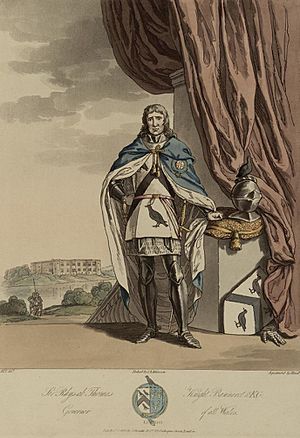Knight banneret facts for kids
A knight banneret was a special type of medieval knight. These knights were important leaders who commanded their own group of soldiers during wartime. They were easy to spot because they carried their own unique square-shaped banner (flag). This was different from regular knights who only carried a smaller, pointed flag called a pennon.

A knight banneret's rank was higher than a regular knight (called a knight bachelor). However, they were not as high-ranking as a duke or an earl. In England, a king or queen usually made someone a knight banneret right on the battlefield. This showed how brave and important they were in a fight.
The wife of a knight banneret was called a banneress.
How Knight Bannerets Started
In the Middle Ages, there weren't armies like we have today that were always ready. Instead, kings and lords gathered their soldiers when they needed them. Many knights served their lord because they had promised to, or they were hired for a specific war.
Important lords had their own special group of fighters, called a 'mesnie'. This group was the best part of their fighting force. By the early 1100s, these important lords started using a square banner to show off their family's special symbol. This banner was a sign of their power and authority.
The idea of a knight banneret grew because some great lords didn't have a fancy family title like "count" or "duke." They wanted a way to show they were more important than regular knights. So, they created a special rank for knights who could carry their own banner.
The first time we see this special rank mentioned was in 1179 at a big royal event in France. Knights who "carried a banner" were listed separately. By the mid-1200s, "banneret" became a clear military and social rank. It meant a senior knight or a lesser lord. The idea of bannerets spread to other countries like Flanders and Germany.
For a while, there was some confusion between the title of "baron" (a family title) and "banneret" (a military rank). They were often the same person! But "baron" was used for their everyday life, and "banneret" was used when they were fighting. Knight bannerets also got paid more during wars than regular knights.
The last time knights banneret were officially created was by King Charles I in 1642 at the Battle of Edgehill. For example, John Smith became a banneret for bravely saving the royal flag from the enemy.
Later Mentions
After the 1600s, the title of knight banneret was rarely used. Some historians debate if any were created later. For instance, some records suggest King George II made 16 knights banneret in 1743 at the Battle of Dettingen. Also, Captains Trollope and Fairfax were said to have been honored by King George III after the Battle of Camperdown in 1797. However, these later awards were not officially recorded in the same way as earlier ones.
Even though the title wasn't really used anymore, knight bannerets were still listed in official tables of importance until at least 1870. Those created by the king on the battlefield were considered very important.
Royal Air Force Idea
When the Royal Air Force (RAF) was created in 1918, they wanted new and unique names for their officer ranks. This was to make them different from the Royal Navy and the British Army.
"Banneret" was one of the names suggested for a high-ranking RAF officer, like a naval captain or an army colonel. However, this idea was not chosen. Instead, the rank of Group Captain was adopted for the RAF.
See also
- List of knights banneret of England

